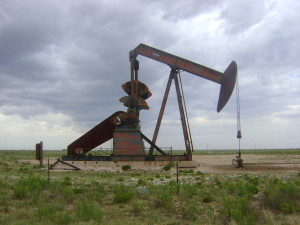Oil prices may go back up — and that’s good news for New Mexico

A BOUNCE BACK?: Oil prices are dropping fast but an energy forecaster predicts the price is heading back to a level that will ensure New Mexico producers will keep pumping.
By Rob Nikolewski │ New Mexico Watchdog
Plummeting gasoline prices may be good news for drivers, but in places like New Mexico there are worries that low prices will mean a big hit to the state budget.
The state, you see, relies on oil and gas revenue for a critical share of the state’s general fund.
But Christopher Hansen, senior director at for IHS Energy, based in Denver, predicts the dip at the pump won’t last long.
“Oil prices will go up,” Hansen told attendees at an energy outlook conference in Albuquerque last week, saying prices could top $150 a barrel after a couple years.
It’s been estimated that money generated from oil and gas production and taxes in New Mexico account for 31.5 percent of the state’s general fund. Before the recent drop at the pumps, financial analysts were expecting an extra $285 million in the upcoming budget year.
That may be in jeopardy if prices stay low.
“A $1 drop in the price of a barrel of oil means a $6 million drop in the general fund,” New Mexico Oil and Gas Association president Steve Henke told the conference.
Oil prices were at $115 a barrel in June. Last week, prices dropped below $75 a barrel. That’s led to the national average retail price of gasoline falling from $3.19 a gallon one year ago to $2.92 a gallon last week, the lowest since December 2010. There are some stations in New Mexico where drivers can find gas for $2.44 a gallon.
That’s great for motorists, but it worries state legislators and economists because it’s generally accepted that $70 a barrel is the tipping point that would prompt the industry to curb production. At that price, the costs of drilling would outweigh the profit.
But Hansen, whose company analyzes the economics and geopolitical landscape of the energy industry, predicts oil prices will rebound.
“Our longer term outlook is that they’ll recover slowly throughout 2015 and into ’16,” Hansen told New Mexico Watchdog, saying IHS forecasters based their conclusion on a number of demand factors, including geopolitical uncertainty. “I think some of the big question marks are how is production going to stabilize in the OPEC areas … and we see a steady demand from Asia.”
Some media reports have expressed alarm that the price of oil could drop even further, but IHS forecasters don’t think that will happen, absent a dramatic and unforeseen international development.
“The price trajectory we see is basically from now ’til the end of next year,” Hansen said. “We’ll see a slow recovery back to about the hundred-dollar level on a nominal level. We think things will stabilize around a hundred bucks (a barrell) through 2016 and then a likelihood to creep back up from there.”
Hansen painted an encouraging energy picture for New Mexico, putting the state among those expecting to average 3-4 percent real GDP growth:
When it comes to crude oil, domestic production is going up because of technological advancements such as horizontal drilling, even as consumption has stayed flat in recent years:
As for natural gas, Hansen said supplies in the U.S. should keep expanding while consumers can expect to keep paying relatively low rates for the foreseeable future:
Hansen said there is a 25-year supply at less than $4 per thousand cubic feet.
New Mexico’s San Juan Basin is home to one of the world’s most plentiful natural gas deposits. While flat prices have kept production in the area quiet, Hansen said predictability could help the New Mexico economy in the long run.
“The good news is, the relatively stable price environment makes it easier to plan,” Hansen said. “One of the nice things about the shale plays is that it’ll take out some of the volatility in natural gas. You’ll see less of these huge spikes and drops. So it’s very unlikely we’ll get down to two bucks. It’s also equally unlikely we’ll get above 10. So from a state budgeting standpoint, you’ll have more stability .”









